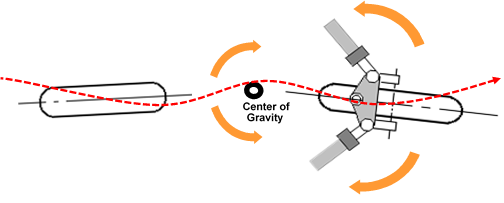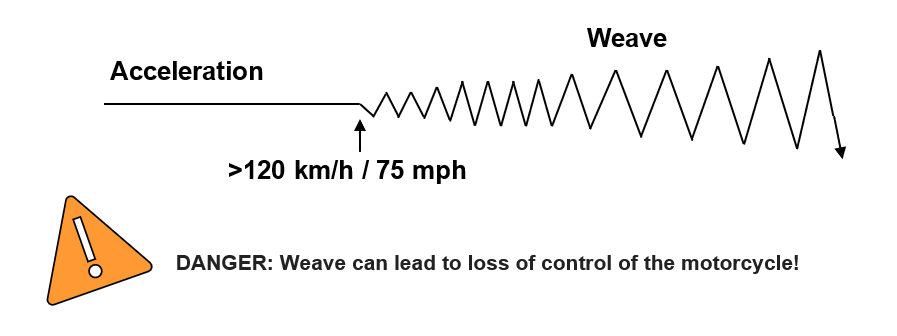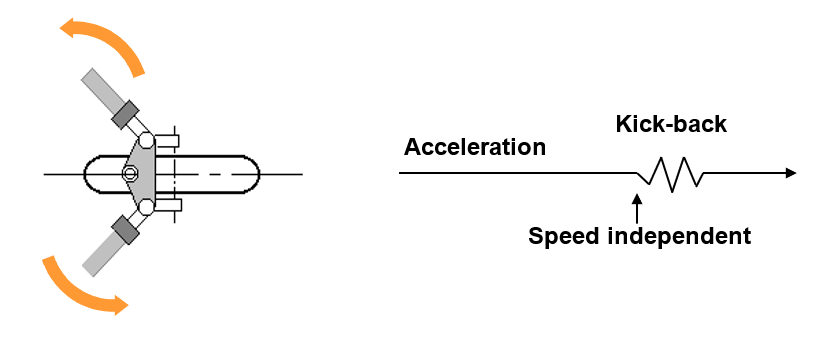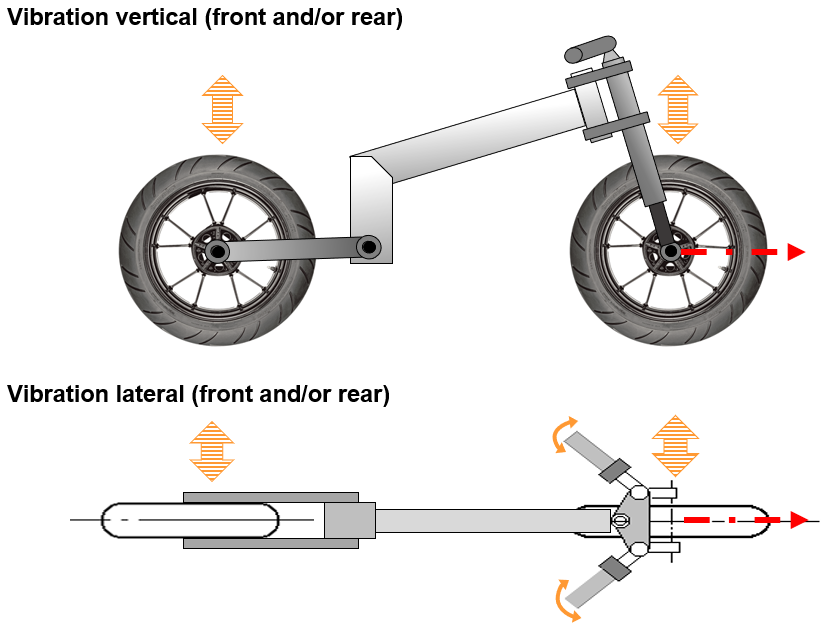Visit Continental Tires in your country for local vehicle fitment
# Tire Knowledge
Motorcycle stability issues
and how to solve them
What is a Motorcycle Stability Issue?
A Motorcycle Stability Issue can be defined as a discomfort of the rider and/or passenger while the vehicle is in normal use. This discomfort may appear randomly or constantly and can be a cyclic shaking, shimmy, or wobble and can affect the complete motorcycle or only parts of it.
(Low Speed) Shimmy / Wobble
Shimmy or Wobble describes a rapid (4-10 Hz) oscillation of primarily just the front end (front wheel, fork, and handlebars) at low speeds (100-40 km/h / 60-25 mph). It occurs mostly during deceleration and the amplitude of the oscillation is usually decreasing with the speed of the motorcycle.

Shimmy usually doesn’t lead to a loss of control but can get worse if a firm grip is not maintained on the handlebars.
Often Shimmy / Wobble is described as a weave, but Shimmy only affects the front end and disappears while accelerating to higher speeds – opposite to the so-called weave, see next topic.
Contributing factors for (Low Speed) Shimmy / Wobble:
- Inflation pressure
- Wear condition of tire, especially of front tire
- Imbalance / run-out of front tire
- Different front/rear tires
- Rim irregularities (esp. spoked rims)
- Worn or misadjusted steering head bearings
- Improper maintained front fork
- Mass distribution of the load (passenger, luggage…)
(High-Speed) Weave
With the so-called High-Speed Weave, the steering system (with fork and front wheel) and the motorcycle rear (with frame, engine and rear wheel) oscillates phase-shifted around the steering axle. At the same time, the machine tilts around the vehicle's longitudinal and vertical axle. It manifests itself as an undulating movement of the vehicle, between 2 and 4 cycles per second (2-4 Hz), followed by a "S" shaped trajectory on the road.

The phenomenon usually appears from 120 km/h / 75 mph depending on the type of motorcycle and environmental conditions (especially wind can cause High-Speed Weave). The weave often starts after a prolonged period of riding at a constant speed and becomes more severe as the speed increases. It can only be stopped by reducing the throttle, whereas the amplitude increases with increasing speed.

Contributing factors at the motorcycle for High-Speed Weave:
- Inflation pressure of the tires
- Wear conditions of the tires (especially worn rear tire with new front tire)
- Additional attachments (top case, side bags, superbike handlebar, wind shield...)
- Mass distribution of the load (passenger, luggage…)
- Rear wheel alignment (not aligned with front wheel)
- Imbalance / run-out of tires (especially rear tire)
- Loose swing arm and wheel bearings
- Too soft / damaged rear wheel dampers
- Environmental conditions (especially wind)
- Wide, loose clothes of the rider
- Improper maintained steering head bearings and fork
Kick-Back
Kick-back is, when the fork, including front wheel and handlebar, jolts suddenly around the steering axle. This effect is independent from riding speed and is triggered when the front tire lifts off and then returns at an angle, such as when accelerating strongly from bends or riding over a bump in a curve. Depending on the speed and the angle of contact, the front tire suddenly builds up lateral forces, which are noticeable in the handlebars as light twitch or a strong jolt.

Usually, a kick-back includes one or two alternating movements of the handlebars around the steering axle and then the chassis calms down very quickly.
Contributing factors at the motorcycle for Kick-back:
- Very sporty motorcycle geometry
- Damping adjustment too hard
- Mass distribution of load (too less load on the front)
- Tire pressure
Lack of Directional Stability
A lack of directional stability describes various phenomena which do not usually repeat themselves cyclically or occur continuously, but which affect the driving characteristics of the motorcycle in certain driving situations, e.g.:
- Poor accuracy of steering movements
- Lack of cornering stability (especially in tight corners)
- High inertia when turning in / turning over in curves
- Poor directional stability on straight roads
Contributing factors at the motorcycle for riding stability issues:
- Inflation pressure of the tires
- New tires with high tread depth / block profile (especially Dual Purpose/Cross tires)
- Wear conditions of the tires (especially spotty wear, heel and toe wear, center wear)
- Imbalance / run-out of tires
- Loose swing arm and wheel bearings
- Improper maintained steering head bearings and fork
- Additional attachments (top case, side bags, superbike handlebar, wind shield...)
- Rear wheel alignment (not aligned with front wheel)
Vibrations
Vibrations creates a discomfort while riding in various common riding conditions and can be noticed by a slightly shaking handlebar, seat or footrests. The movement direction caused by the vibration may be vertical, lateral or even mixed and can affect the front or rear part of the motorcycle.
Mostly, vibrations come from rotating or oscillating masses that are out of balance. It may also be caused by components and parts that are not fixed properly or have too much play. Therefore, poor maintenance of the motorcycle often leads to vibration problems.

Vibrations usually occurs at an unspecific speed - depending on the natural frequency of the affected system - and its amplitude remains stable or decreases over rising velocity.

There are various conditions that can cause vehicle vibrations. Typical sources are:
- Tire wear shape (uneven wear)
- Static/dynamic Imbalance / Run-Out of tires
- Tire flat spot due to long vehicle parking period
- Tire to rim mounting
- Rim irregularities (esp. spoked rims)
- Improper maintained steering head bearings and fork
- Worn out chain and belt drive
- Worn wheel bearings
- Improper maintained engine